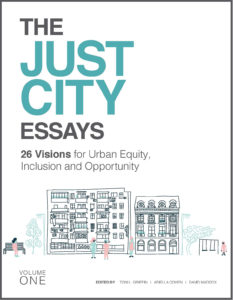“Five years ago, the Harvard Graduate School of Design’s Just City Lab published The Just City Essays: 26 Visions of Inclusion, Equity and Opportunity. The questions it posed were deceptively simple: What would a just city look like? And what could be the strategies to get there? These questions were posed to mayors, architects, artists, philanthropists, educators and journalists in 22 cities, who told stories of global injustice and their dreams for reparative and restorative justice in the city.
 These essays were meant as a provocation, a call to action. Now, during these times of dissonance, unrest, and uncertainty, their contents have become ever more important. For the next 26 weeks [starting June 15, 2020], the GSD and the Just City Lab will republish one essay a week here and at designforthejustcity.org. We hope they may continue conversations of our shared responsibility for the just city.
These essays were meant as a provocation, a call to action. Now, during these times of dissonance, unrest, and uncertainty, their contents have become ever more important. For the next 26 weeks [starting June 15, 2020], the GSD and the Just City Lab will republish one essay a week here and at designforthejustcity.org. We hope they may continue conversations of our shared responsibility for the just city.
We believe design can repair injustice. We believe design must restore justice, especially that produced by its own hand. We believe in justice for Black Americans. We believe in justice for all marginalized people. We believe in a Just City.”
—Toni L. Griffin, Professor in Practice of Urban Planning, founder of the Just City Lab, and editor of The Just City Essays
A Democratic Infrastructure for Johannesburg
By Benjamin Bradlow
There are two main legacies that define urban inequality in South Africa: housing and transport. Apartheid was not only a racial ideology. It was also a spatial planning ideology.
Johannesburg’s development into a wealthy, white core of business and residential activity, with peripheral black dormitory townships, was a result of specific legislation and government action accountable only to white citizens. Black people were confined to houses in townships that had little economic value. Black townships were synonymous with urban poverty. These houses were far away from business activity and jobs. As population movement controls eroded in the late 1980s, informal settlements began to concentrate next to formal townships. The story of Johannesburg, the financial center of South Africa, can help understand how the struggle to build these connections defines the extent to which Johannesburg can be considered “just.”
Today, Johannesburg offers unique insights into the prospects for other cities in Africa. This is not because most cities in Africa are similar to or are likely to become similar to Johannesburg. But Johannesburg has a basic historical characteristic that resembles that of many African cities: it was planned for inequality. Johannesburg’s uniqueness also marks it as a lodestar for other African cities. It is a meeting point of migrants from all over the continent, and an economic engine of growth on the continent. These flows of people, money, and goods, in and out of the city, mean that the impact of the city is continental.
The notion of a just city in Africa will have to accommodate the extent to which the hopes of earlier generations of social scientists and policy-makers for rural-led development on the continent have now been rendered moot by economic patterns that are both global and local. In Johannesburg, one of the most industrialized cities on the African continent has become a magnet for rural South Africans, and international migrants from other African countries. The primary infrastructural challenge is not only about identifying technical shortcomings or mere numbers of delivery. It is about generating the voice from below to demand that infrastructure reach those who need it most, and to ensure the political will to manage contentious distributional decisions about land and public finances.
I want to show why this is so difficult, and how, in order to make the decisions that are “just,” we need to first make sense of the history that lies behind those decisions. Continue reading on designforthejustcity.org…
